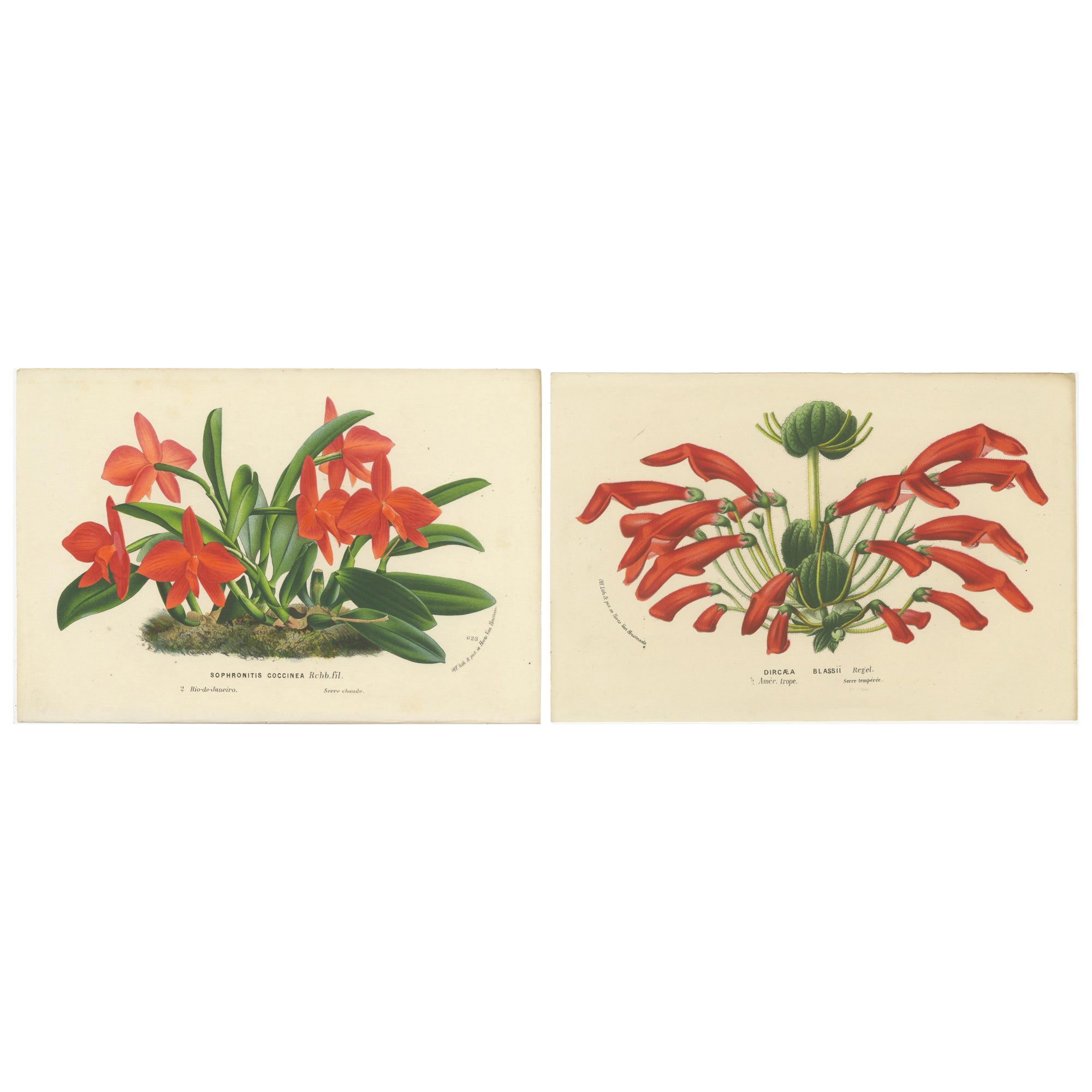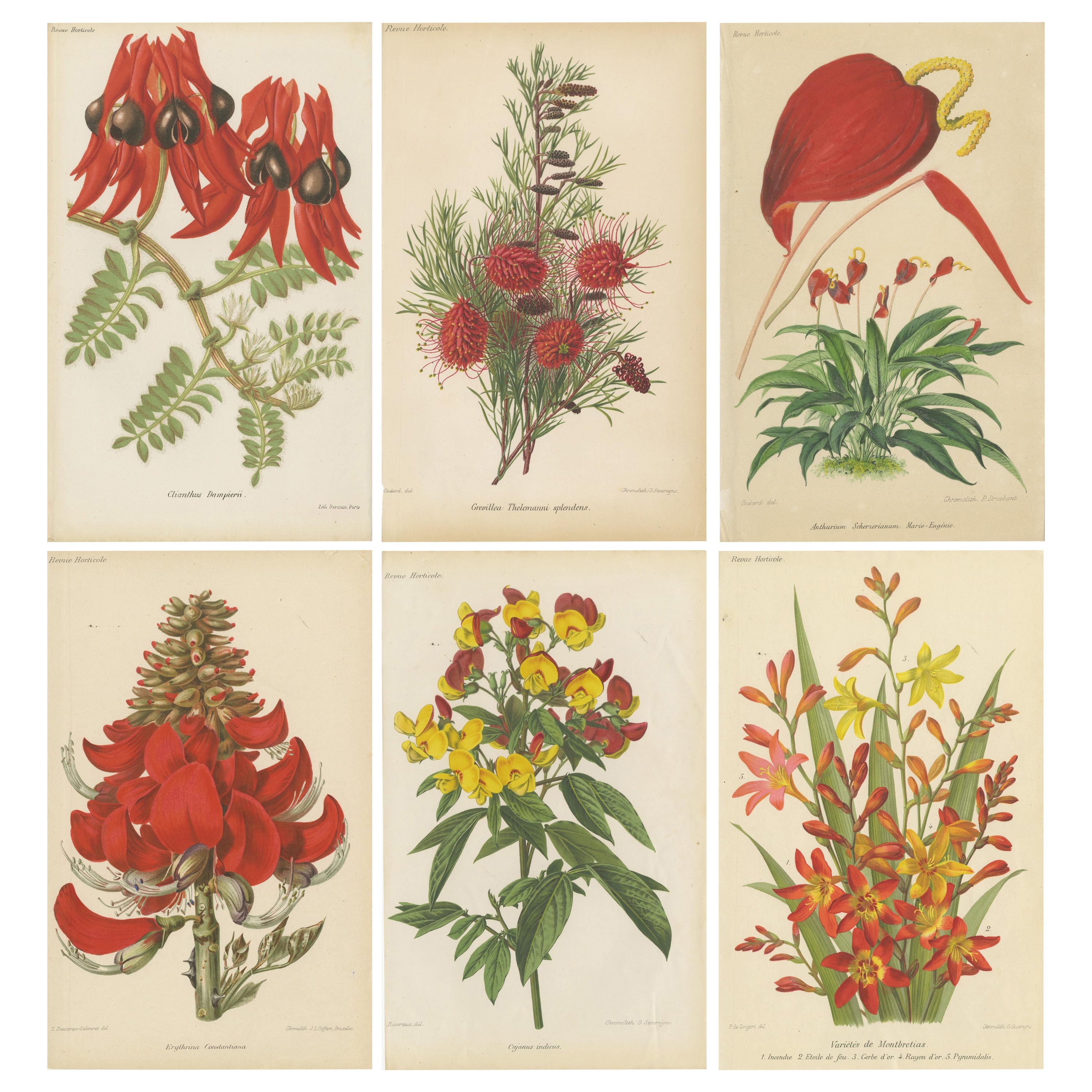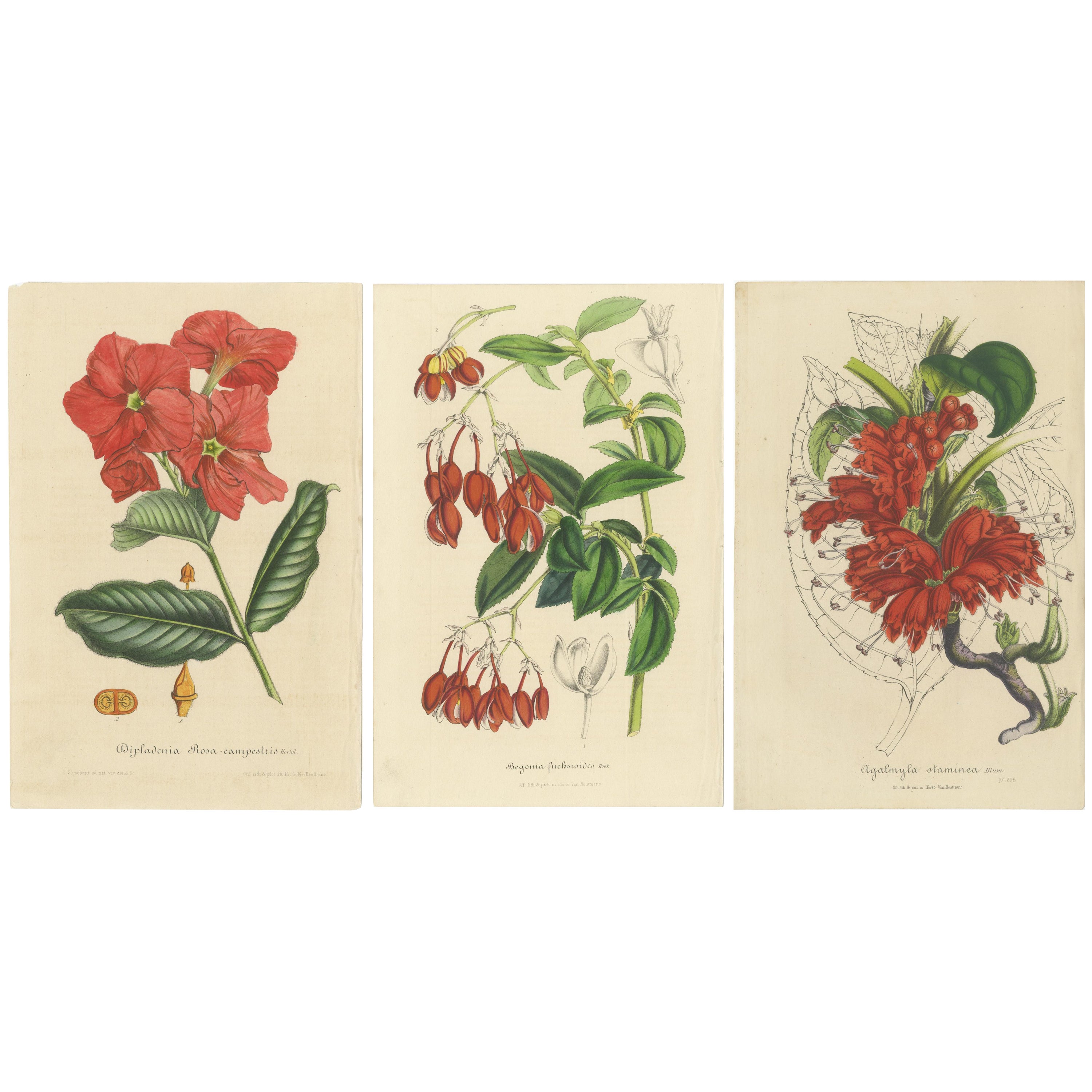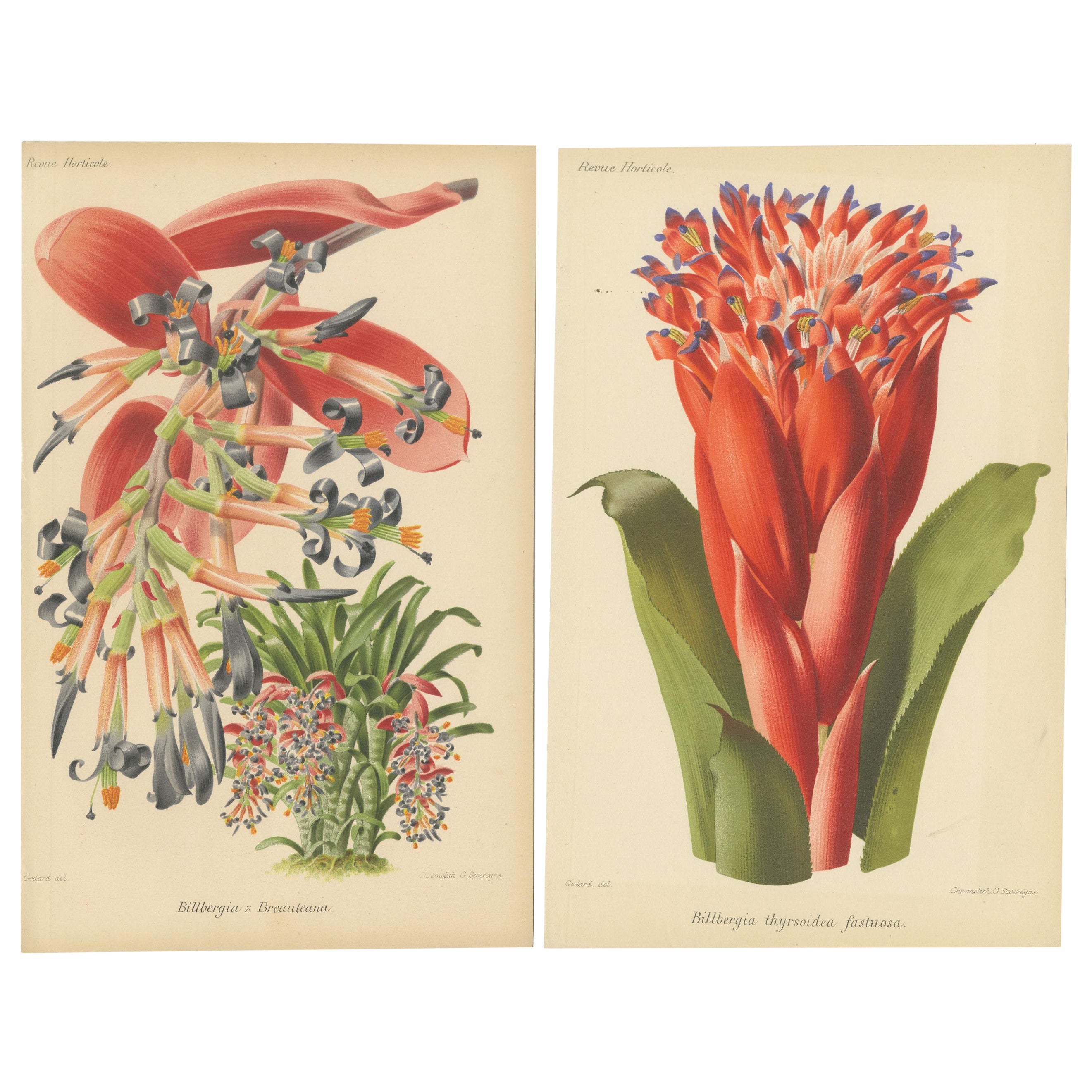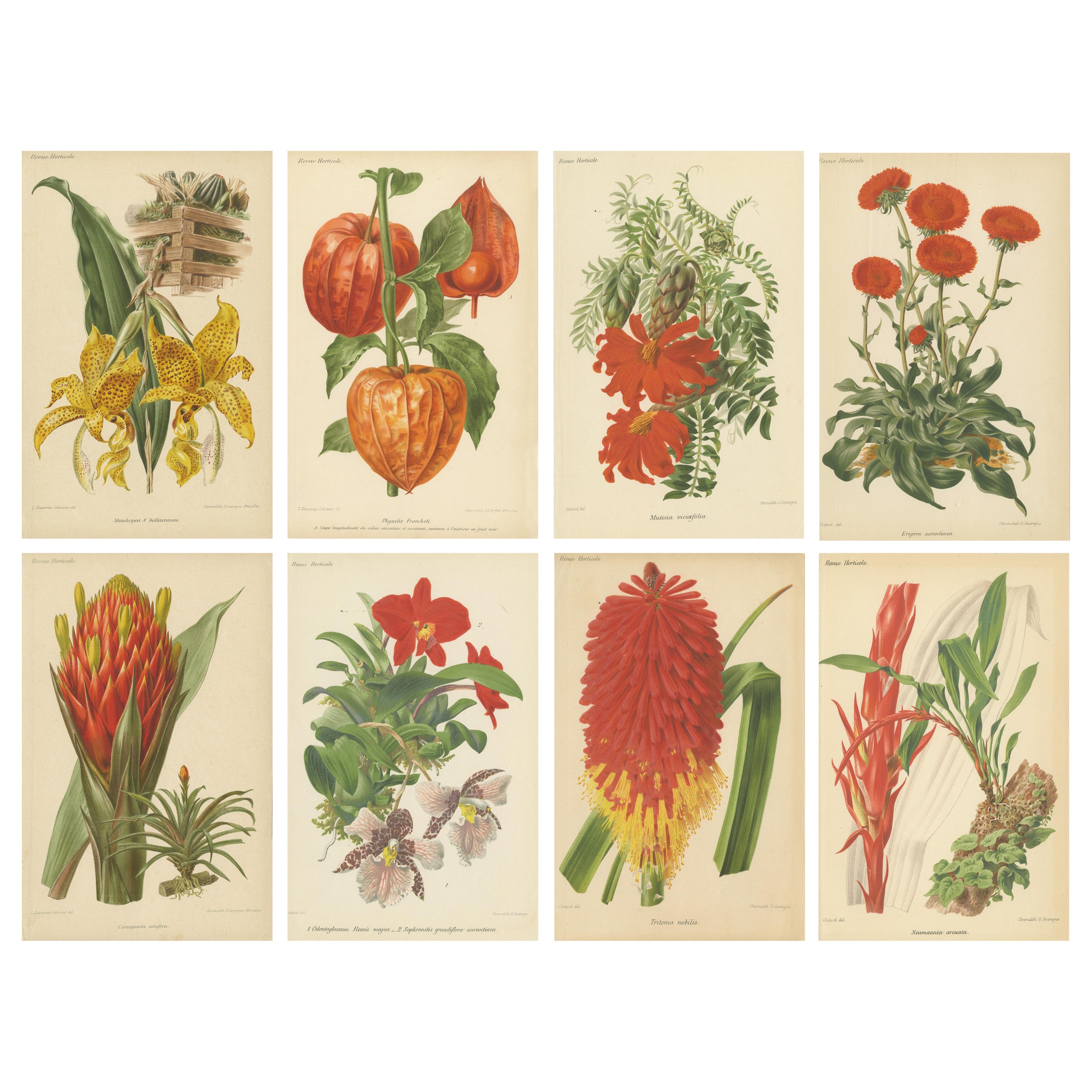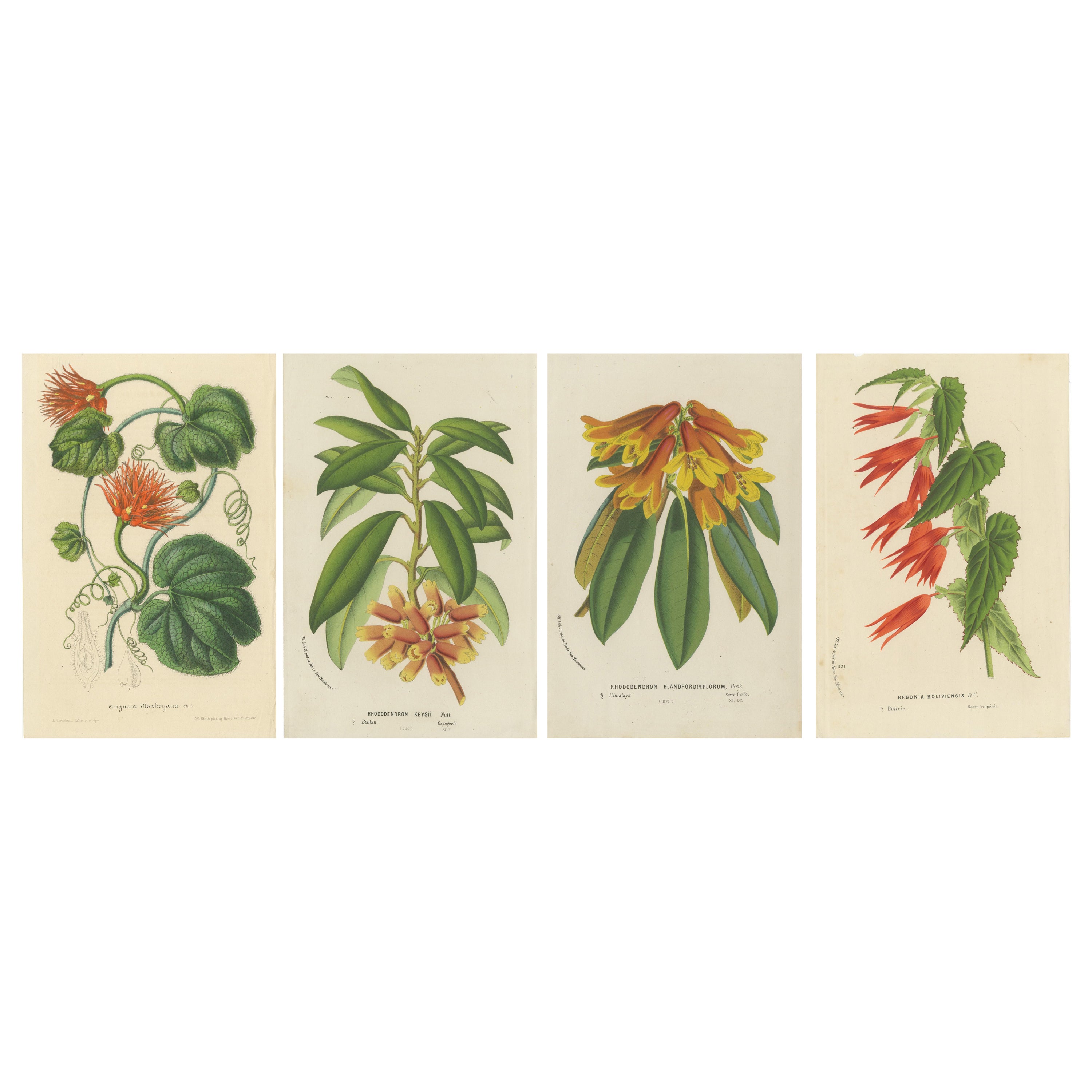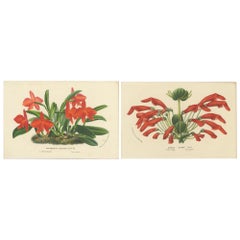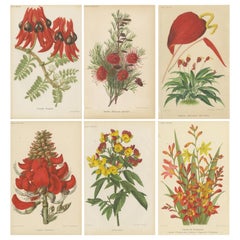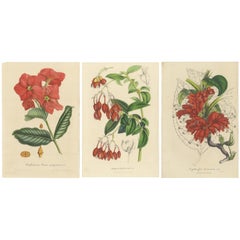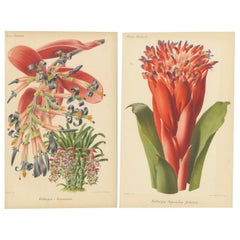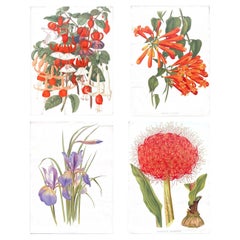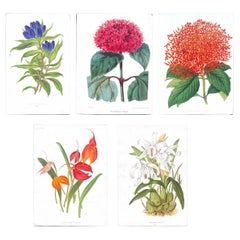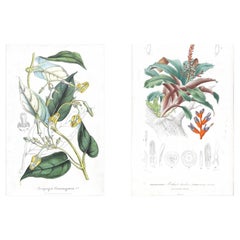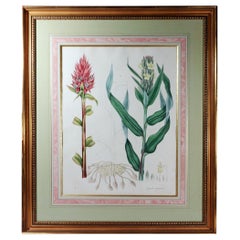Items Similar to Vibrant Botanical Lithographs: Flamingo Flower and Sturt's Desert Pea, c.1855
Want more images or videos?
Request additional images or videos from the seller
1 of 8
Vibrant Botanical Lithographs: Flamingo Flower and Sturt's Desert Pea, c.1855
$114.20per set
$142.75per set20% Off
£84.60per set
£105.75per set20% Off
€96per set
€120per set20% Off
CA$157.08per set
CA$196.34per set20% Off
A$174.71per set
A$218.39per set20% Off
CHF 91.65per set
CHF 114.57per set20% Off
MX$2,131.90per set
MX$2,664.88per set20% Off
NOK 1,150.38per set
NOK 1,437.97per set20% Off
SEK 1,084.09per set
SEK 1,355.12per set20% Off
DKK 730.93per set
DKK 913.66per set20% Off
About the Item
Description of the Combined Lithographs
Left Image: Anthurium Scherzerianum
This lithograph features the Anthurium Scherzerianum, commonly known as the Flamingo Flower or Laceleaf, originating from Guatemala.
This plant is recognized for its vibrant red spathes and uniquely coiled spadix, which make it a popular choice for ornamental purposes. The illustration captures the plant's striking red flowers and glossy, dark green leaves. The image is characterized by its rich color palette, bringing the exotic beauty of the Anthurium to life.
Right Image: Clianthus Dampieri fl. albo
The right lithograph illustrates the Clianthus Dampieri, also known as Sturt's Desert Pea. This plant is native to Australia and is celebrated for its distinctive, pea-like flowers, which in this particular variety are shown in a combination of red, black, and white colors.
The flowers have a characteristic elongated shape with a glossy appearance, complemented by the plant's delicate green foliage. The vivid depiction in the lithograph highlights the striking contrast and unique form of this iconic Australian plant.
Both lithographs come from the 19th-century botanical publication "Flore des Serres et des Jardins de l'Europe" by Louis van Houtte, a prominent Belgian horticulturist. Known for his detailed and vibrant plant illustrations, van Houtte's work aimed to capture the diversity of global flora.
The lithographs are colored by hand, a technique that enhances their visual appeal and scientific accuracy.
The condition of these prints is good, showing minor signs of aging like foxing and browning, typical of antique botanical artworks. This set has a rich patina. These images reflect the 19th-century fascination with exotic plants and the desire to document and celebrate botanical diversity.
- Dimensions:Height: 9.45 in (24 cm)Width: 6.3 in (16 cm)Depth: 0.01 in (0.2 mm)
- Sold As:Set of 2
- Materials and Techniques:
- Period:
- Date of Manufacture:Circa 1855
- Condition:The condition of these prints is fair, showing minor signs of aging like foxing and browning, typical of antique botanical artworks. This set has a rich patina.
- Seller Location:Langweer, NL
- Reference Number:Seller: BG-13748-25, BG-13748-261stDibs: LU3054341294482
About the Seller
5.0
Recognized Seller
These prestigious sellers are industry leaders and represent the highest echelon for item quality and design.
Platinum Seller
Premium sellers with a 4.7+ rating and 24-hour response times
Established in 2009
1stDibs seller since 2017
2,591 sales on 1stDibs
Typical response time: <1 hour
- ShippingRetrieving quote...Shipping from: Langweer, Netherlands
- Return Policy
Authenticity Guarantee
In the unlikely event there’s an issue with an item’s authenticity, contact us within 1 year for a full refund. DetailsMoney-Back Guarantee
If your item is not as described, is damaged in transit, or does not arrive, contact us within 7 days for a full refund. Details24-Hour Cancellation
You have a 24-hour grace period in which to reconsider your purchase, with no questions asked.Vetted Professional Sellers
Our world-class sellers must adhere to strict standards for service and quality, maintaining the integrity of our listings.Price-Match Guarantee
If you find that a seller listed the same item for a lower price elsewhere, we’ll match it.Trusted Global Delivery
Our best-in-class carrier network provides specialized shipping options worldwide, including custom delivery.More From This Seller
View AllBotanical Vintage Prints of Scarlet Sophronitis and Tropical Bloom, c.1845
Located in Langweer, NL
The prints are from Louis Van Houtte's and Charles Lemaire's "Flore des Serres et des Jardins de l'Europe," a detailed collection of botanical lithographs showcasing plants grown in ...
Category
Antique 1840s Prints
Materials
Paper
$228 Sale Price / set
20% Off
Exquisite Botanicals: Clianthus, Grevillea, Anthurium, and More, circa 1885
Located in Langweer, NL
Description of the Prints with Latin and English Names
Clianthus Dampieri
English Name: Glory Pea or Dampier's Clianthus
Description: This print features striking, bright red flower...
Category
Antique 1880s Prints
Materials
Paper
$456 Sale Price / set
20% Off
Exquisite Botanical Illustrations from Curtis’s Botanical Magazine (1847)
Located in Langweer, NL
These beautiful hand-colored botanical illustrations, drawn and lithographed by the renowned artist Walter Hood Fitch, were featured in Sir William Jackson Hooker's *"Curtis's Botanical Magazine,"* published in London in 1847. Fitch was one of the most prolific and skilled botanical illustrators of the 19th century, known for his ability to capture the intricate details and vibrant hues of the plants he depicted.
Sir William Jackson Hooker, a famous British botanist and the director of the Royal Botanic Gardens, Kew, commissioned these illustrations as part of his work to document newly discovered plants from around the world. The *Curtis’s Botanical Magazine* has been published since 1787 and remains one of the longest-running botanical periodicals.
Detailed Descriptions of Each Plant
#### 1. **Dipladenia Rosa-campestris** (*Hortul. ex Veitch*)
- **English Name**: Rose Dipladenia
- **Description**: This illustration showcases *Dipladenia rosa-campestris*, a striking flowering plant known for its showy pink to deep red trumpet-shaped flowers. Native to tropical regions of South America, particularly Brazil, *Dipladenia* belongs to the family Apocynaceae and is prized in horticulture for its vibrant blooms and ability to climb. Fitch's illustration emphasizes the waxy leaves and the vivid color of the petals, bringing the plant to life on the page.
#### 2. **Begonia fuchsioides** (*Hook.*)
- **English Name**: Fuchsia-flowered Begonia
- **Description**: The *Begonia fuchsioides* is depicted with its characteristic red, pendulous flowers, which closely resemble the blooms of fuchsia plants. This species of Begonia is native to tropical regions and is popular for its delicate, bell-shaped flowers and glossy leaves. Fitch’s attention to the arrangement of the leaves and the contrast between the flowers' vibrant red and the soft green leaves provides a lifelike representation of this exotic plant.
#### 3. **Agalmyla staminea** (*Blume*)
- **English Name**: Staminate Agalmyla
- **Description**: This illustration captures the unique red tubular flowers of *Agalmyla staminea*, a plant native to Southeast Asia. The species is part of the Gesneriaceae family and is known for its bright, showy flowers that grow in dense clusters. Fitch’s careful rendering of the plant’s leaves and the intricate veining, along with the vibrant red flowers, highlights his talent for bringing the botanical subject to life with both scientific accuracy and artistic flair.
### About the Makers
#### **Walter Hood Fitch** (Artist and Lithographer)
Walter Hood Fitch (1817–1892) was one of the most influential botanical artists of the 19th century, working primarily with Sir William Hooker and later his son, Joseph Dalton Hooker, at Kew Gardens. He produced thousands of illustrations for various botanical publications, including *Curtis’s Botanical Magazine*, where he was responsible for the majority of its plates from 1834 to 1877. Fitch’s mastery of lithography allowed him to create richly detailed and accurate depictions of plants, with a particular talent for illustrating both the botanical structure and the vibrant colors of flowers.
#### **Sir William Jackson Hooker** (Director and Editor)
Sir William Jackson Hooker (1785–1865) was a prominent British botanist and the director of the Royal Botanic Gardens, Kew. Under his leadership, Kew Gardens expanded its collection of plants from around the world, and Hooker was instrumental in promoting the scientific study and illustration of these species. As the editor of *Curtis’s Botanical Magazine*, Hooker collaborated with Fitch to document and share the beauty and diversity of plants with the scientific community and the public.
### The Lithographic Technique
Lithography, particularly chromolithography, was a crucial innovation in botanical illustration. Fitch was skilled in the traditional method of lithography, where an image was drawn onto a stone plate with a greasy substance and then inked for printing. Hand-coloring was often applied afterward to bring the prints to life, as seen in these illustrations. This method allowed for highly detailed, accurate representations of plants and their botanical features, making it invaluable for both scientific study and aesthetic appreciation.
### Conclusion
These prints from *Curtis’s Botanical Magazine* reflect the height of botanical art in the mid-19th century. The combination of Walter Fitch...
Category
Antique 1840s Prints
Materials
Paper
$409 Sale Price / set
20% Off
Stunning Bromeliads: Queen's Tears and Flaming Torch in Artful Display, c.1855
Located in Langweer, NL
The prints are from "Revue Horticole," a prominent horticultural periodical known for its high-quality botanical illustrations, which served both educational and ornamental purposes....
Category
Antique 1850s Belgian Prints
Materials
Paper
$214 Sale Price / set
25% Off
Original Vintage Botanical Illustrations from Revue Horticole, circa 1855
Located in Langweer, NL
Here are descriptions of the eight botanical illustrations, including the Latin and English names of the plants, why they are significant, and details about the creators and the tech...
Category
Antique 1850s Prints
Materials
Paper
$637 Sale Price / set
20% Off
Lush and Vibrant: A Collection of Exotic Botanical Illustrations, circa 1875
Located in Langweer, NL
The prints depict a selection of exotic plants with a remarkable detail and vibrant color, showcasing the beauty and diversity of botanical life. Each illustration is a testament to ...
Category
Antique 1870s Prints
Materials
Paper
$390 Sale Price / set
20% Off
You May Also Like
Original 1880s Botanical Print of Hæmanthus Kalbreyeri — Vibrant Antique Chromol
Located in Fukuoka, JP
A striking original chromolithograph from the 1880s, this botanical print features the dramatic Hæmanthus kalbreyeri, also known as the blood lily. Characterized by its intense red s...
Category
Antique 19th Century French Prints
Materials
Paper
Bignonia venusta – Antique Botanical Chromolithograph, 1880s
Located in Fukuoka, JP
A striking original botanical print from the 1880s, featuring Bignonia venusta, also known as flame vine or orange trumpet vine. This brilliantly colored illustration captures the dr...
Category
Antique 19th Century French Prints
Materials
Paper
Set of Two Rare Botanical Engravings by D’Orbigny — 1849
Located in Fukuoka, JP
Set of Two Rare Botanical Engravings by D’Orbigny — Dictionnaire Universel d’Histoire Naturelle, Paris, 1849
An exquisite pair of original hand-colored botanical engravings from the...
Category
Antique 19th Century French Prints
Materials
Paper
William Roscoe Botanical Large Print of Tropical Plant, Zingiber Capitatum
Located in Downingtown, PA
William Roscoe Botanical Large Print,
Zingiber Capitatum,
Monandrian Plants of the Order Scitamineae,
1828
A spectacularly large and beautifully framed botanical print. The subjects...
Category
Antique Early 19th Century English Regency Prints
Materials
Paper
Pair of Original Vintage Botanical Prints, circa 1900
Located in St Annes, Lancashire
Great images of medicinal plants
Unframed.
Published, circa 1900.
Free shipping
Category
Antique Early 1900s English Edwardian Prints
Materials
Paper
Parrot-Headed Pitcher Plant Botanical Print on Paper, USA Early 20th C.
Located in South Salem, NY
A color print of a Parrot-Headed Pitcher Plant on paper. This print captures the essence of the native to the US blooming plant of the northern landscape with delicate finesse. In th...
Category
Early 20th Century American Prints
Materials
Paper
More Ways To Browse
Flamingo Antique
Antique Flamingo Print
Atelier Hugo
Baby Rattle
Black Forest Eagle
Bleached Mahogany Chest
Bombe Box
Brass Pheasant
Brass Pineapples
Bronze Crocodile Sculpture
Bronze Koi
Bronze Lotus Leaf
Bronze Portico Clock
Campaign Writing Box
Capiz Table
Carved Ducks
Carved Giraffe
Carved Oak Cabinet French Bar
